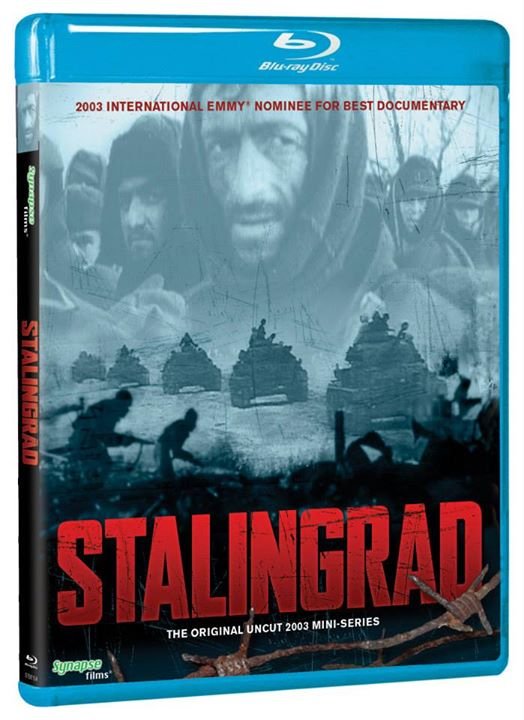STALINGRAD (2003): The Human Cost Of National Pride
Any student of World War II knows that the battle of Stalingrad is the place where the tide turned against the Third Reich, a loss that kickstarted the decline that would eventually result in their defeat. However, this turning point took a long time to occur and left countless thousands dead on both sides of the battle before it was all over. Those swept up in the narrative of history can often forget the immense personal cost that underwrites the turns of that narrative - and the three-part documentary miniseries Stalingrad provides a powerful testament to how that human cost looks, sounds and feels.Stalingrad's approach to its material is a mixture of the familiar and the unusual. In classic documentary style, it mixes interviews and oft-harrowing file footage of the battle of Stalingrad as it creates a narrative in three parts: the first segment chronicles the events the culminate in the Nazi attack on Stalingrad, the second segment focuses on how Russians  turned the tables on the Germans and trapped them in the now war-scarred city on all sides and the third segment deals with the defeat of the Germans and the battle's aftermath.What makes Stalingrad unique is that it does not identify the Russian and German survivors who create the oral-history portion of its narrative nor does it focus on a few particular stories to give it an easily digestible narrative spine. Instead, it concentrates on getting a large number of people to provide vignettes without revealing their names. In doing so, it forces the viewer to concentrate on the recurring themes of the storylines they tell: soldiers forced to follow leadership that marches them into death, families being torn apart by the call to war and battle between dehumanizing your enemy versus trying to hold onto humanity in desperate times.The resulting series is powerful because it manages to make such a huge conflict seem so personal. Writers and co-directors Sebastian Dehnhardt and Jorg Mullner pull this off by avoiding getting caught up in statistics and traditional war narratives. Instead, it's a steady stream of people who were on the ground, being affected by the events up-close and in real time, telling you what happened to them and the lingering sorrow they cope with. This ability to make the political personal makes Stalingrad a uniquely powerful World War II documentary.Blu-Ray Notes: Stalingrad was previously released as a DVD by Synapse and has recently been revisited for a blu-ray by the same company. The results look impressive, with the present day HD footage looking appropriately colorful and detailed while the vintage file footage has a new clarity and depth. The audio is a lossless 2.0 stereo mix that delivers the dialogue-driven sound design in a clear, robust manner.This disc also carries over the extras included on the previous DVD. The first is a 17 minute set of interview snippets not used in the film. There is also an 11 minute interview with supervising producer Guido Knopp. Finally, a 3 minute segment entitled "Stalingrad Today" allows the viewer to see what the city looks like: though it is rebuilt and modern, scars of the World War II battles can still be seen.
turned the tables on the Germans and trapped them in the now war-scarred city on all sides and the third segment deals with the defeat of the Germans and the battle's aftermath.What makes Stalingrad unique is that it does not identify the Russian and German survivors who create the oral-history portion of its narrative nor does it focus on a few particular stories to give it an easily digestible narrative spine. Instead, it concentrates on getting a large number of people to provide vignettes without revealing their names. In doing so, it forces the viewer to concentrate on the recurring themes of the storylines they tell: soldiers forced to follow leadership that marches them into death, families being torn apart by the call to war and battle between dehumanizing your enemy versus trying to hold onto humanity in desperate times.The resulting series is powerful because it manages to make such a huge conflict seem so personal. Writers and co-directors Sebastian Dehnhardt and Jorg Mullner pull this off by avoiding getting caught up in statistics and traditional war narratives. Instead, it's a steady stream of people who were on the ground, being affected by the events up-close and in real time, telling you what happened to them and the lingering sorrow they cope with. This ability to make the political personal makes Stalingrad a uniquely powerful World War II documentary.Blu-Ray Notes: Stalingrad was previously released as a DVD by Synapse and has recently been revisited for a blu-ray by the same company. The results look impressive, with the present day HD footage looking appropriately colorful and detailed while the vintage file footage has a new clarity and depth. The audio is a lossless 2.0 stereo mix that delivers the dialogue-driven sound design in a clear, robust manner.This disc also carries over the extras included on the previous DVD. The first is a 17 minute set of interview snippets not used in the film. There is also an 11 minute interview with supervising producer Guido Knopp. Finally, a 3 minute segment entitled "Stalingrad Today" allows the viewer to see what the city looks like: though it is rebuilt and modern, scars of the World War II battles can still be seen.


